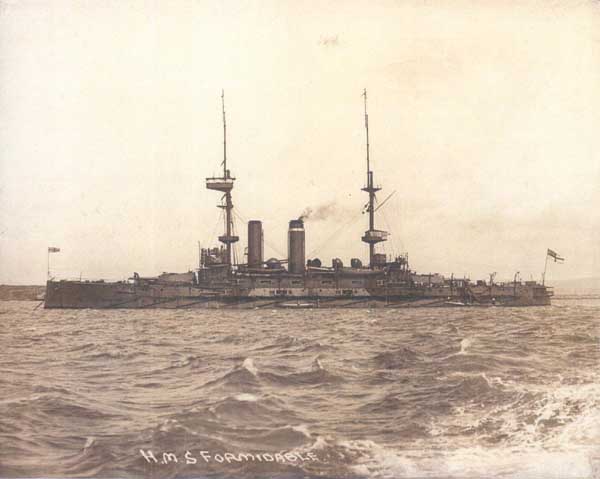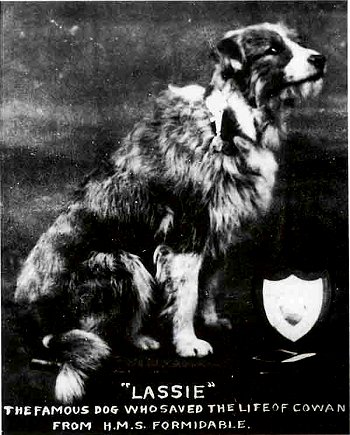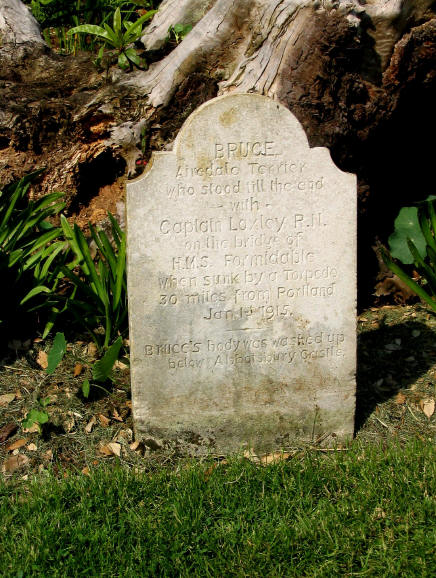
HMS FORMIDABLE. Battleship [60M] – (Excellent detail in Clarke: GPS; 50 13.12N; 02 03.59W.) Considerable detail in DCC. Torpedoed by German Submarine and sunk off Devon but survivors remembered mainly in Lyme Regis. See also Lyme Regis Philpott Museum. Refs. LARN South Devon 1915; Dictionary of Disaster at Sea: 1990 Ed.p248-9; Devon Shipwrecks: 1974 p90 (photograph) 115-6 & 254 & Torquay
DCC:07/01/1915; BRITISH NAVAL DISASTER Loss of a Battleship.
The FORMIDABLE, a battleship of 15,000 tons, completed in 1901, was sunk on Friday in the Channel, with a heavy loss of life. The FORMIDABLE, a sister ship to the IRRESISTIBLE and IMPLACABLE, and to a great extent to the vessels of the VENERABLE class, was laid down at Portsmouth in 1898 and was completed in 1901. She had a displacement of 15,000 tons, length of 400 ft., beam of 75 ft., and draught of 26¾ ft., while her speed was just over 18 knots. Her armament consisted of 4 x 12″, 12 x 6″, 16 x 12 pr., and 2 x 3 pr. guns, and she also carried 4 torpedo tubes. In October, 1901, the FORMIDABLE was commissioned for service in the Mediterranean Fleet. She continued to serve there until August, 1908, when she was paid off to undergo a refit. Less than a year later she was placed in the first Division of the Home Fleet, being subsequently relieved by the SUPERB and transferred to the Atlantic Fleet. In May, 1912, the FORMIDABLE was reduced to nucleus crew at Sheerness for service in the Second Fleet at the Nore. She underwent another refit, which was completed at Chatham in March, 1913, when she was once more commissioned for service. The complement of the ship was about 750 officers and men. Captain Arthur N. Loxley was appointed to the FORMIDABLE on September 2nd last.
In the night of the 31st, at 11 o’clock, the battleship was proceeding up the Channel at between 16 and 18 knots an hour. At the time a south-westerly gale was blowing. The moon was almost at its full, and the night was light, save for intervals of drizzly rain. A big sea was running. At about 1.30 a.m. the silence and stillness of the ship was broken by the report of a loud explosion on the starboard bow forward. There is little doubt that the ship was torpedoed by a submarine. At the moment of the explosion Captain Loxley, together with Commander Ballard and his signalling officer, was on the bridge. The first order given by Captain Loxley was to close the water-tight doors, and in the same breath he ordered the crew to be piped to collision quarters. Every member of the crew, except, of course, those whose duties would keep them below until the order “Every man for himself” came, at once rushed on deck, the majority awakened by the explosion and in their night attire. Then quickly came the order, “Out pinnaces and the launch.” This was followed by a further order, “Way barges 1 and 2.”
Out of the 800 men forming the crew all formed up on deck, with the exception of the 100 or so who were doing the middle watch below and who would await the order, “Clear lower deck.” Perfect order reigned, and, though the seriousness of the situation was fully realised, the light-heartedness which never forsakes the British Tar found expression in the exclamation of one man, “There is a fine New Year gift for us.” At that moment the new year was but an hour old. The first boat, holding between 70 and 80, was got away on the starboard side, and was picked up in a terrible sea by the trawler PROVIDENT, of Brixham, and taken to that port. The story of the skipper’s rescue is one of magnificent seamanship. After being adrift for many hours in a raging sea, a boat with 50 of the FORMIDABLE’s crew drifted into Lyme Regis at midnight. Nine of the sailors died of exposure and were buried at sea. Thrilling stories of rescue and heroism are told by the survivors. Captain Loxley went down with his ship after displaying wonderful fortitude. A number of the rescued men were brought to Portland by a light cruiser.
According to an Admiralty statement only 199 were saved out of a total complement of about 750.
The FORMIDABLE, a battleship of 15,000 tons, completed in 1901, was sunk on Friday in the Channel, with a heavy loss of life. The FORMIDABLE, a sister ship to the IRRESISTIBLE and IMPLACABLE, and to a great extent to the vessels of the VENERABLE class, was laid down at Portsmouth in 1898 and was completed in 1901. She had a displacement of 15,000 tons, length of 400 ft., beam of 75 ft., and draught of 26¾ ft., while her speed was just over 18 knots. Her armament consisted of 4 x 12″, 12 x 6″, 16 x 12 pr., and 2 x 3 pr. guns, and she also carried 4 torpedo tubes. In October, 1901, the FORMIDABLE was commissioned for service in the Mediterranean Fleet. She continued to serve there until August, 1908, when she was paid off to undergo a refit. Less than a year later she was placed in the first Division of the Home Fleet, being subsequently relieved by the SUPERB and transferred to the Atlantic Fleet. In May, 1912, the FORMIDABLE was reduced to nucleus crew at Sheerness for service in the Second Fleet at the Nore. She underwent another refit, which was completed at Chatham in March, 1913, when she was once more commissioned for service. The complement of the ship was about 750 officers and men. Captain Arthur N. Loxley was appointed to the FORMIDABLE on September 2nd last.
Inquest at Lyme Regis
An inquest on 9 victims of the mishap to the FORMIDABLE was held at Lyme Regis by the West Dorset Coroner (Mr. C.G. Nantes, who was accompanied by Mr. F .B. L. Maunsell, deputy-coroner), on Saturday afternoon. The Admiralty was represented by Mr. H. A. Huxtable, of Weymouth, and the Mayor of Lyme Regis (Mr. A. J. Woodroffe) was chosen foreman of the jury.
Mr. Huxtable wished to say, on behalf of the Lords of the Admiralty, how much they and the nation deplored the terrible accident which had caused the loss of so many brave men’s lives. Fortunately among the men saved there were several of considerable intelligence, including Master-at-Arms Cooper, Petty-Officer Bing, and Leading Seaman Carroll, who might be said to represent each grade of the men saved.
Albert Edward Cooper, master-at-arms of the FORMIDABLE, said he was asleep in his hammock on January 1st, between 1.30 and 2.30 a.m., when he heard an explosion in the ship. He continued: I got up and went on deck. She was starting to settle down on the starboard side. The order was given, “Out boom boats.” A pinnace was launched, and got filled with men. She was pushed off from the ship and dropped astern to see if she could pick up any more men. owing to the roughness of the sea the ship soon went out of sight. After we had been pulling roughly an hour or two we could see four white lights, which appeared to be in a bunch, and two separate. We started pulling towards these. We then saw two red lights in the bay. It must have been about 5 o’clock in the evening when we saw the white lights, and as we drew near, land was sighted. Everybody was then all right in the boat, except one man, who was slightly injured, but we were all suffering from exposure. We were scantily clad, and experienced cold and snow and hail storms. We had to bail out water from the pinnace three-parts of the day. Some men died in the boat later, purely from exposure. The boat was absolutely full when we started. When we had been pulling towards the white lights about 2 hours we found we were making no headway, the tide being against us, so we turned the boat round and pulled towards the red lights. We landed safely on the beach about 11 o’clock, so that we had been from half past two in the morning till, 11 o’clock at night on the water. When we landed 6 men were dead, in the boat, and 3 expired when they got on shore. There was no physical injury to anyone. The boat, contained no food or water, as time did not permit of provisioning it.
Petty Officer Herbert Bing said: I was in one of the turrets when the explosion occurred. I had the idea it was gunfire. I went on deck and the boats were being got out. I got into the pinnace, and we stood by the ship for some time. It was very stormy and rough, and we had a job to keep the boat head on to the waves. We kept on picking up men. The last I saw of the ship was a lot of men standing on the quarter-deck, many of them smoking.
Thomas Carroll, leading seaman, gave corroborative evidence.
P. S. Stockley, Lyme Regis, said that he heard shouting at a quarter to 11 on New Year’s night and went down to the sea front and saw a boat about 400 or 500 yards out. He sent for assistance, and after a time the boat came ashore.
Dr. Cooper, of Lyme Regis, gave evidence that the cause of death was exposure.
The jury returned a verdict that the men died from exposure at sea in consequence of an accident having occurred to their ship.
The funeral of the 9 victims of the disaster whose bodies were landed at Lyme had been arranged to take place on Monday afternoon. Early in the morning, however, instructions were received from the Admiralty postponing the funeral until Wednesday to give effect to their latest order that those relatives desirous of having the burial at home should be allowed to do so. Simultaneously an order was received by the local representative of the Admiralty, Lieutenant Holliday, that all those survivors who were well enough to travel should be sent on to Chatham, the home port of the FORMIDABLE. Dr. Cooper, who has been attending the men, examined them, but found the majority were quite unfit to travel.
The men at Lyme expressed a wish to attend the funeral of their late comrades, but the Admiralty order that those fit to travel should return to their home port would prevent a number of them doing so. On hearing of this, the Mayor (Mr. F. J. Woodroffe) telegraphed to the Admiralty asking for permission to be granted to the men to stop, which was granted.
Gallant Act by a Dorset Police Sergeant.
P. S. Stockley was the first one to sight the boat that put into Lyme Regis. About 11 p.m. on Friday night he was on the Marine Parade and heard shouting from the direction of the bay. Looking out to sea he could discern nothing, but a little later he noticed a boat about 400 yards from the shore, and he sent P.C. Rideout for assistance. In the meantime the boat gradually drew near to the beach, and one of the sailors threw a rope to the sergeant, who succeeded in getting a hold upon it. By seizing this rope, which was attached to the boat, one of the seamen was soon able to get ashore, and two others quickly followed. Another of the crew, while attempting to get ashore by the same means, became so weak and exhausted that he was unable to maintain his grip on the rope, and fell into the raging surf. P. S. Stockley at once ran into the surf, and, grasping hold of the unconscious sailor, succeeded in pulling him out on to the beach – a courageous act that is deserving of the warmest commendation. Only 2 or 3 of the men had sufficient strength to get out of the boat when it had been beached. P. S. Stockley, with the aid of Coxswain Abbott and P. C. Rideout, removed the other sailors from the craft, and they were promptly treated by Drs. J. Spurr and H.J. Cooper. There were 6 dead men in the boat and 48 survivors, but 3 of the latter died after being landed, and 12 bodies were thrown overboard while the boat was at sea.
DCC: 14/01/1915;
A launch belonging to the FORMIDABLE – the one in which the 70 men were rescued by the Brixham fishing smack – was washed up here (Fleet) in a terribly battered condition on Sunday morning there being also various articles of clothing in the boat.
DCC: 21/01/1915;
Mayor Mr. A. J. Woodroffe (Lyme) started a fund to erect a gravestone for the grave of the 6 victims of the FORMIDABLE buried there.
DCC: 12/08/1915;
The loss of the FORMIDABLE – On Monday an interesting ceremony took place at the Guildhall, when a boat’s crest was presented to the town by a number of the survivors of the FORMIDABLE in recognition of the kindness extended to them when they landed here after the disaster to the ship. The crest, which was attached to the boat which brought them to land, has been suitably mounted and inscribed, and will be one of the most cherished possessions of the town.
DCC; 23/09/1915;
Memorial to FORMIDABLE Victims – There has been erected in the little hillside cemetery here an imposing memorial to the victims of the crew of the battleship FORMIDABLE, which was torpedoed by a German submarine last January. The memorial, which takes the form of a granite Celtic cross on three massive bases, stands immediately over the graves of six of the nine men who, it will be remembered, died from exposure as the result of the terrible gale in which they were buffeted about in their boat for 20 hours after leaving the battleship. The Mayor (Mr. Woodroffe) was responsible for raising the fund for the memorial, which was liberally subscribed to by his townspeople. The Admiralty also contributed as well as the relatives of the victims. On the cross is the following inscription in raised letters:- “Sacred to the memory of William Feldon, petty officer, aged 36; Horace E. Bernthall, stoker, aged 31; William C. Eley, stoker, aged 24; William Fawkes, stoker, aged 31; Henry Souter, stoker, aged 27; Bernard A. de P. Smythe, boy, aged 17, who lie buried here. They formed part of the crew of His Majesty’s ship FORMIDABLE, sunk by torpedo attack from a German submarine on January 1st, 1915, when 34 officers and 511 men were drowned.”
Notes:
1 – Was sunk by two torpedoes from German Submarine U-24, 20 miles off Start Point.
 2 – Along the Marine Walk in Lyme Regis is the Pilot Boat Inn. This pretty pub was the home of the original Lassie. It seems that many years ago the The Pilot Boat’s landlady, Mrs. Atkins, had a dog named Lassie, a rough-haired collie. The dead from the FORMIDABLE were carried down to the inn’s cellar and laid on the flagstone floor. There lay the corpses, but Lassie persisted in licking the face of one of them, even when rebuked and called away. His name was John Cowan; he made a faint movement, revived, and was nursed back to complete health! This true story was later used as an inspiration for the series of Lassie books, films, and television series. Lassie was awarded two animal medals.
2 – Along the Marine Walk in Lyme Regis is the Pilot Boat Inn. This pretty pub was the home of the original Lassie. It seems that many years ago the The Pilot Boat’s landlady, Mrs. Atkins, had a dog named Lassie, a rough-haired collie. The dead from the FORMIDABLE were carried down to the inn’s cellar and laid on the flagstone floor. There lay the corpses, but Lassie persisted in licking the face of one of them, even when rebuked and called away. His name was John Cowan; he made a faint movement, revived, and was nursed back to complete health! This true story was later used as an inspiration for the series of Lassie books, films, and television series. Lassie was awarded two animal medals.
Photographs of Lassie, along with Able Seaman John Cowan, appeared in the newspapers and on postcards. The journalist Eric Knight (born in Yorkshire in 1897) will have heard of her, and he gave her name to the heroine of his 1938 Saturday Evening Review serial story, later extended to a novel, Lassie Come Home.
 3 – There is a second Doggy Story. Captain of the FORMIDABLE, Arthur “Noel” Loxley ordered the signaller to warn off any ships that might come to the rescue, since they too might be struck. With him at the bridge was his dog, Bruce, a three-year-old Airedale-crossed-with-Irish-terrier, who refused to leave him for a lifeboat. This story is told at greater length in Captain Loxley’s Little Dog by “the author of Where’s Master?”, with epilogue by R. M. Franklin, Diggory Press, 2003. Loxley’s body was never recovered; Bruce’s was washed up on Chesil Beach and buried with a headstone in the pet graveyard in the Abbotsbury gardens. Right
3 – There is a second Doggy Story. Captain of the FORMIDABLE, Arthur “Noel” Loxley ordered the signaller to warn off any ships that might come to the rescue, since they too might be struck. With him at the bridge was his dog, Bruce, a three-year-old Airedale-crossed-with-Irish-terrier, who refused to leave him for a lifeboat. This story is told at greater length in Captain Loxley’s Little Dog by “the author of Where’s Master?”, with epilogue by R. M. Franklin, Diggory Press, 2003. Loxley’s body was never recovered; Bruce’s was washed up on Chesil Beach and buried with a headstone in the pet graveyard in the Abbotsbury gardens. Right
References:
Dictionary of Disasters at Sea 1990 Ed. p248-9.
Devon Shipwrecks 1974, p90 by R. Larn.
Day of Loss: 1
Month of Loss: 1
Year of Loss: 1915
Longitude: 50 13.12
Latitude: 02 03.59
Approximate Depth: 60
